The Kilt. Just saying that conjures up images of HIghlanders walking through the Scottish Glens. it is one of the most recognisable national dress seen in the Western World. All over there are women, and men, swooning at the thought of a man in a kilt, c’mon readers I know you’re all thinking it and smiling. There has been a decline in national dress for the majority of western cultures, it is either mocked and or dying out. Not us, the Scots. We are proudly embracing ours, just as our ancestors did throughout the centuries, but I’m pretty sure they just thought of it as clothing. We take pride in our national dress and are still, to this day, allowing it to evolve.
As I mentioned, the kilt is associated around the world with romantic visions of Highlanders. This is mainly to do with the writing of Sir Walter Scott and his obsession with re writing Scottish cultural history with his rose tinted glasses.
The kilt actually started out as a functional item of clothing. There would have been a lot of rural cultures that may have had a similar cloak/blanket style of garment when working on the land. Even the ‘criss cross’ weave that we recognise as tartan will have been seen in other cultures.
Some of the first written evidence of a kilt like garment that we see is from a publication in 1582 of a 25 volume called ‘The History of Scotland’ The author George Buchanan describes the kilt as consisting of a tightly woven cross striped woollen length of cloth worn as a garment by day and blanket by night. This is a description of what we would call a belted plaid or a great kilt. It was a large piece of woollen cloth that may have had the criss cross weave or just plain, depending on how adventurous the local weaver was. It was made from 2 pieces of cloth around 28 inches wide (the size of a hand loom) and 3 – 4 yards in length, these 2 pieces were then sewn together at the width, making the cloth double width. The Highlander would lay the cloth down, pleat the middle section (to get the excess cloth out of the way) and wrap it around the body with a belt. By tucking in the corners of the longer piece you make pockets.
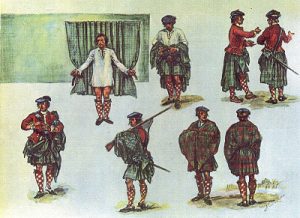
If you ever go to a Scottish Highland games or re enactment, go down to the car park, its quite surreal, and funny, watching the gentlemen putting on their plaids. Just for the record I only watch to make sure they are putting them on correct… Honest. The bottom part of the kilt would’ve been a lot shorter than todays kilts. The reason for this is very simple; Scotland’s weather, which is known to have four seasons in one day. When walking through the the wet heather, in the rain or snow, the cloth would get wet causing it to harden. Now if kilts were at the length we see today then the cloth would cut the back of the legs. As late as the 1960s the majority of kilts were being worn well above the knee. In fact when I first started in the industry we had an older gentleman that dressed our windows, he wore his kilt rather short. Believe me it was not a pretty sight especially when ladders were being used.
There was a very clever firm, who shall remain nameless , marketed a ‘new style’ of kilt. They called it thee hillwalker kilt. It was a normal kilt but made slightly shorter with less material, so when you’re up in the wet heather you’ll not cut the back of your legs. How clever, why didn’t we think of it before.
Now for a wee mental image. They say that when HIghlanders were about to run into battle with the famous Highland charge, they would undo their belts and let their plaids drop to the ground so they could run and fight, in close quarters, unhindered. I would think at the same time freaking out their enemy.
The start of the 18th century saw the beginning of Industrialisation in Scotland. The first being in textiles, then Iron and steel, heavy engineering and ship building. With the political union of 1707 it opened up markets not only to England but also the rest of the British Empire.
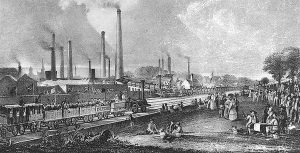
Mill towns started popping up all around Scotland. This led to rural men and women, who for generations had worked the land reaping little reward, flocked to the towns for new, hopefully better, opportunities. Due to the different working conditions, going from working outdoors to indoors, especially in confined spaces, the belted plaid or great kilt would have been to far too large and cumbersome. It was only natural that a version of the small kilt we see today would have evolved.
There is a story stating that, it was, in fact an Englishman who invented the small kilt, the forerunner of the kilt we wear today. This comes from a letter that was published in a popular pamphlet of the time ‘The Edinburgh Magazine’ in 1785
This is not true and has been seen as a myth for sometime now. The kilt has naturally evolved over the years. It started off as a multi functional garment worn by people working the land, as industrialisation came along and the functions of the garment changed. Some of the cloth would have naturally been shed an in time this cloth would have been sewn, as it is no longer needed as a blanket, and would make it easier to put on.
After the Jacobite rebellion rebellion of 1715 a number of acts were passed attempting to disarm the Highlands. These weren’t very successful as they couldn’t really be enforced. The government had sent General Wade up into the wilderness of Scotland to build roads to help the British army control and govern the highlands. They didn’t think those pesky Highlanders could also use the roads.
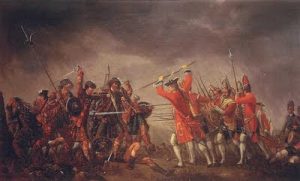
In 1746 new acts were introduced by the British parliament following the Jacobite defeat at Culloden. This was the last pitched battle ever fought on the British Isles between Government forces and the Jacobite army. Let me stress, this was not English against Scots. Bonnie Prince Charlie fled the field to South Uist and then on to France. His Jacobite supporters and any other Scot that was in his path were left to the wrath of the butcher, the Duke of Cumberland, and his medieval reprisals. The acts of proscription from 1746-47 not only disarmed the Highlander but this time tried to rob them of everything that made them who they were which included their dress. This time the act was fiercely enforced. The penalties of found armed or wearing any form of Scottish garb were 6 months imprisonment for the first offence, if convicted again it could mean jail or transportation to the colonies for 7 years as indentured slaves. The Highland regiments were exempt from the act.
The act was in place for nearly 36 years encompassing practically a whole generation of Scots. Finally, on July 1st 1782 Royal Assent was given to repeal the act proscribing the wearing of Highland dress. This was thanks to a group of 25 Highlanders in London who had formed to help support the economic recovery in Scotland. However, by the time the ban had been lifted the majority of Highlanders would’ve been accustomed to wearing the same dress as Lowland Scots, so there was little enthusiasm to return to the old style. Lets face it, not may folk could’ve been able to afford a new wardrobe.
What we see now today as kilts and tartan comes from the romantic revival of Highland dress back in the early nineteenth century thanks to the author Sir Walter Scott. When king George IV was due to visit Edinburgh in 1822, Scott and Stewart of Garth were asked to stage manage the whole event. Sir Walter Scott, who had an obsession with re creating his own romantic version of gaelic culture and Highland dress, asked all who were attending the functions, to wear full Highland dress in their own family tartan. There was so much wrong with this ask as not only did most of the guests not have any ‘highland dress’ there was no such thing as family tartans… yep you read right, there was no such thing as clan tartan. This caused a wee bit of panic. There were a few Clan chiefs that had their own tartan woven. Those who didn’t descended en masse to the weaving mills to get a tartan woven or choose one from those that were already in production. Tartans at this time were not named but numbered. so, most customers came along picked one they liked and from that moment on wards it was their clan tartan. Wilsons of Bannockburn, one of the weaving mills around at the time, had to build new weaving sheds to keep up with demand, even taking staff from other areas of the business to fulfil orders and for the next 10 years the mill solely wove tartan. Once the tartans were woven there was then the rush to get all the ‘traditional’ highland dress tailored. Even the King was kitted out.
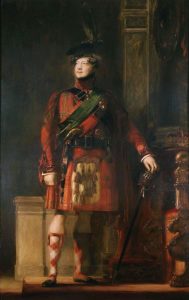
The Tailors and tartan shops made a fortune that year and this is were we get different pleat styles in tailored kilts. A lot of the tailors engaged in making the kilt outfits for this event would never have seen a kilt and would simply be making the outfit how they thought it would look like. It is because of this there are so many different pleat styles. One of the oldest surviving tailored kilt is from 1794 and this is a box pleated kilt and the tartan is set to the stripe.
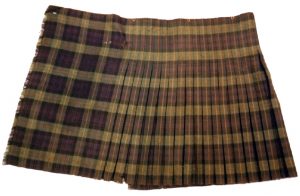
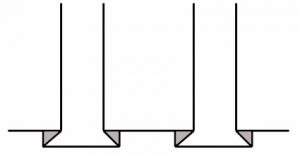
There are a few Kingussie pleated kilts, named after the area the kilt was found in, that have survived from 1822, I believe these are an example of Tailors making it up as they go along.
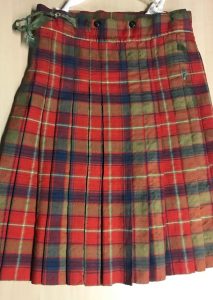

As these kilts have survived through the years there are some people who say they are the most traditional style of kilt. As a kiltmaker I don’t agree, after all which was the pleat used in the original belted plaid, it was a knife pleat. So I would say this is the oldest style of pleat and still the most popular style of kilt today.
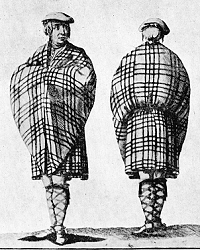
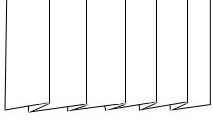
The Yardage in a kilt has also grown through the years. Up until the early 20th century kilts were still only 3 – 4 yards and the tartan pleated to the stripe, or with no order at all. It was the early 1900s that some smart arse came up with the idea of making the pleats on the back of the kilt to look like the front apron of the kilt, we call this pleating to the sett.
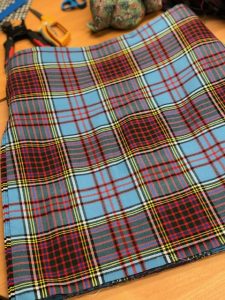
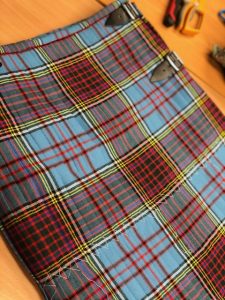
With the influx of new tartans being woven, the techniques and the abilities of new machinery within larger factories meant that variations of different setts and different sett sizes could now be woven. There was no way this would be possible with only 4 yards of material and so through the years the amount of cloth grew until the 8 yards we see today. This is now the most popular way of setting up a kilt. I’m sure the weavers didn’t think of us poor kiltmakers that would have to make it.
There are some kilt shop retailers out there that will offer kilts with less yardage, thinking it will save the customer money or make them more money. However, this actually causes quite a headache for the kiltmaker as, sometimes, making it up to the sett with only 4 or 5 yards of tartan is just not possible and, quite frankly, makes the kilt look terrible. Trying to explain this to retailers and the sales people is like hitting your head off a brick wall and just shows the lack of knowledge and respect they have for the kiltmaker. Unfortunately this is helping the decline of the craft of kiltmaking.
The details we see on a tailored kilt have also evolved through time, like a fringe, having a sewn waistband, sporran loops and now its quite common to see a second buckle and strap on the hip. We now see kilts in different fabrics and have pockets. I am sure it wont end there, the kilt will continue to evolve in to the next generation and generations after.

Thank you for the history of the kilt. My Nan, born In Montrose 1898, swore that a real kilt had quite a number of yards to it. Mind you no one would question her.
This is wonderful reading, thanks for sharing.
Interesting information, especially as to the selection of tartans by the clan chiefs in 1822. Today we may see new tartan designs with meaning to every thread and efforts to assign meaning to older tartans.
It would be enlightening to discuss the aspects of tartan styles – hunting, dress, ancient, muted, modern, etc.